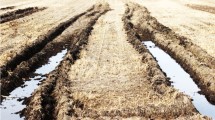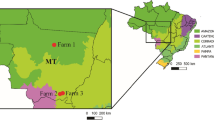Abstract
Major changes have taken place in the agricultural factor input structure in China, which will inevitably affect fertilizer input in agriculture. However, there is no consistent conclusion about the impact of capital and labor input on chemical fertilizer input. This paper employed directed acyclic graphs (DAGs) to clarify the influence of capital-labor input structure on the use of chemical fertilizer. Using inter-provincial panel data, the dynamic panel system GMM method was adopted to examine the mechanism of factor substitution elasticity in determining the impact of agricultural capital-labor input on chemical fertilizer input. The results showed that agricultural labor and capital input are positively correlated with chemical fertilizer input. In the process of capital and labor input affecting fertilizer input, the elasticity of factor substitution plays a negative moderating role. From 1996 to 2018, the trend of capital replacing labor was evident, and the increase ratio of capital input was greater than the decrease ratio of labor input. Therefore, an increase in capital input and its substitution for labor is the main driver of the increase in fertilizer input. At the same time, the elasticity of fertilizer-capital substitution declined during the period 1996–2018, thereby reinforcing the increase in fertilizer input caused by the increase in capital input. In order to reduce agricultural pollution caused by the increase in chemical fertilizer input, it is crucial to reverse the declining trend in the elasticity of fertilizer capital substitution.





Similar content being viewed by others
Data availability
All data and materials are available if the paper is published.
Notes
In general, the US dollar is known worldwide, so using the dollar as a unit of measurement is better for global readers to understand China’s agricultural situation. Nevertheless, the materials used in Chinese agricultural production are mainly sourced in China, while farmers’ agricultural products are mainly sold in mainland China. Therefore, their production decisions and sale expectations are mainly influenced by production costs and expected sales revenue measured in RMB and are not sensitive to the US dollar. Due to the floating exchange rate of RMB against USD, choosing USD as the currency unit inevitably leads to bias in empirical results. To ensure the reliability of the empirical results and the uniformity of the currency units used throughout the paper, we use the unit of measurement in RMB (Yuan) as the currency unit.
Among them, Hong Kong and Macau have narrow geographical areas, secondary and tertiary industries are dominant in their economies, and agriculture occupies a negligible share of their economies. Tibet is not included in this article due to the lack of partial data related to the estimation of fixed capital stock. There are significant differences between the statistical systems in Taiwan and the mainland of China, and some of the data required for this paper are missing, so Taiwan is excluded from the progress of empirical analysis. As a result, these four regions will generally be excluded from studies of China.
\({K}_{t}\mathrm{ and}\) \({K}_{t+1}\) represent the current and prior period fixed capital stock, and the base period fixed capital stock is calculated according to Li's (2014) method.
For the period 1996–2002, data for gross fixed capital formation were obtained from Data of Gross Domestic Product of China, while in 2003–2018 the data were derived based on the weight of fixed asset investment in the primary industry relative to total social fixed asset investment.
According to Li (2014), the depreciation rate was selected as 5.42%. This was calculated from the efficient depreciation rate of agricultural capital, the Trial Regulations on Depreciation of State-Defined Assets of State-Owned Enterprises, and weighted data from Enterprise Accounting Standards.
The data for Beijing, Shanghai, Tianjin, and Chongqing between 1996 and 2002 was missing, so this was replaced by the retail price index for food.
To test the robustness of the empirical results, in studying the influence of labor L on fertilizer input, we exclude the variable INCOME and control for EDUC, FIS-EXP, K, P, and POLICY. The results show that the sign and significance of the core explanatory variables’ coefficients remain unchanged.
To test the robustness of the empirical results, when examining the impact of capital K on fertilizer input, we eliminate the variable INCOME and only control for EDUC, FIS-EXP, L, P, and POLICY. In this study, it is found that the sign of the coefficients of the core variables and their significance are unchanged.
The purpose of this paper is to analyze the impact of capital inputs and the moderating role of the factor elasticity of substitution on fertilizer inputs. Therefore, only the measurement results are briefly presented without detailed analysis.
Data for Tibet is not included in any of the tables. According to the National Bureau of Statistics (https://data.stats.gov.cn/), the country is divided into three major geographical regions: eastern, central, and western.
It is calculated by using the formula \({\sigma }_{KL}=(1+(2{\beta }_{kl}-{\beta }_{kk}\frac{{\eta }_{Lit}}{{\eta }_{Kit}}-{\beta }_{ll}\frac{{\eta }_{Kit}}{{\eta }_{Lit}})/({\eta }_{Kit}+{\eta }_{Lit}){)}^{-1}\) and combined with the estimated parameters in Table 2.
As an example, relative factor prices are significant determinants of factor inputs, but it is difficult to obtain data on the relative prices of capital, labor, and fertilizer. In the absence of price variables, the backdoor path to capital and labor inputs that affect fertilizer inputs will be linked, which will cause endogeneity problems.
The Hausman test statistic of 111.47 with a p value of 0.000 indicates that endogeneity exists. In this paper, static panel model and dynamic panel GMM estimation results are compared, and the results show a significant difference, and there is an endogeneity issue. Consequently, it is reasonable to use dynamic panel system GMM estimation.
As a result of space constraints, fixed effects regression results cannot be shown.
Total effect of labor on fertilizer input is computed as \({\beta }_{1}\)+\({\beta }_{3}{\upsigma }_{FL}\), or 0.0596–0.0236*\({\upsigma }_{FL}\). Labor and fertilizer inputs in the model are expressed as logarithms, so the total effect is the change in fertilizer input as a percentage of the change in labor input. Similarly, the total effect of capital inputs on fertilizer inputs in the latter section is similar to the impact of capital inputs as a percentage change in fertilizer inputs for changes in capital inputs.
The total effect of capital inputs on fertilizer input is \({\beta }_{4}+{\beta }_{6}{\mathrm{\sigma }}_{FL}\), which is 0.4704-0.2948*\({\mathrm{\sigma }}_{FK}\).
The marginal effect of labor input on fertilizer input is \({\beta }_{1}\)+\({\beta }_{3}{\upsigma }_{FL}\), which is 0.0596–0.0236*\({\upsigma }_{FL}\).
The marginal effect of capital input on fertilizer input is \({\beta }_{4}+{\beta }_{6}{\mathrm{\sigma }}_{FK}\), which is 0.4704-0.2948*\({\mathrm{\sigma }}_{FK}\).
References
Acemoglu D (2002) Directed technical change. Rev Econ Stud 69(4):781–809. https://doi.org/10.1111/1467-937X.00226
Cao H, Zhao K (2018) Influence factors and effect decomposition of households’ intention of chemical fertilizer reduction: an empirical analysis based on VBN-TPB. J Huazhong Agric Univ: Soc Sci Ed 6:29–38. https://doi.org/10.13300/j.cnki.hnwkxb.2017.04.008
Castellano MJ, Archontoulis SV, Helmers MJ, Poffenbarger HJ, Six J (2019) Sustainable intensification of agricultural drainage. Nat Sustain 2(10):914–921. https://doi.org/10.1038/s41893-019-0393-0
Chang HH, Mishra AK (2012) Chemical usage in production agriculture: do crop insurance and off-farm work play a part? J Environ Manage 105:76–82. https://doi.org/10.1016/j.jenvman.2012.03.038
Chen X, Ma L, Ma W, Wu Z, Cui Z, Hou Y, Zhang F (2018) What has caused the use of fertilizers to skyrocket in China? Nutr Cycl Agroecosyst 110(2):241–255. https://doi.org/10.1007/s10705-017-9895-1
Cinelli C, Forney A, Pearl J (2022) A crash course in good and bad controls. Sociol Methods Res. https://doi.org/10.1177/00491241221099552
De La Grandville O (1989) In quest of the slutsky diamond. Am Econ Rev 79(3):468
Gao J, Peng C, Shi Q (2019) Study on the high chemical fertilizer consumption and fertilization behavior of small rural household in China: discovery from 1995–2016 National Fixed Point Survey Data. Manag World 35:120–132. https://doi.org/10.19744/j.cnki.11-1235/f.2019.0136
Gong Q W, Tian Z H (2010) The Kuznets curves’ hypothesis and validation of the correlation between rural economic growth and chemical fertilizers consumption. J China Agric Univ (Soc Sci Ed) (04):157–164. https://doi.org/10.13240/j.cnki.caujsse.2010.04.020
Guo L, Li H, Cao X, Cao A, Huang M (2021) Effect of agricultural subsidies on the use of chemical fertilizer. J Environ Manage 299:113621. https://doi.org/10.1016/j.jenvman.2021.113621
Hicks JR (1932) The theory of wages. Macmillan Press, London
Hou JD, Lv J, Yin WF (2012) Effects of farmer households’ production and operation behaviors on rural eco-environment. China Popul Resour Environ 22(3):26–31
Hu Y, Li B, Zhang Z, Wang J (2019) Farm size and agricultural technology progress: evidence from China. J Rural Stud. https://doi.org/10.1016/j.jrurstud.2019.01.009
Huang SA, Sun SM, Gong MB (2005) The impact of land ownership structure on agricultural economic growth: an empirical analysis on agricultural production efficiency on the Chinese mainland (1949–1978). Soc Sci China 3:38–47
Jiang L, Li Z (2016) Urbanization and the change of fertilizer use intensity for agricultural production in Henan Province. Sustainability 8(2):186. https://doi.org/10.3390/su8020186
Karabarbounis L, Neiman B (2014) The global decline of the labor share. Q J Econ 129(1):61–103. https://doi.org/10.1093/qje/qjt032
Kong XZ, Zhang C, Zhang JR (2018) The change of factor endowment and the improvement of the organic composition of agricultural capital– an explanation of the path of agricultural development in China since 1978. Manag World 34(10):147–160. https://doi.org/10.19744/j.cnki.11-1235/f.2018.10.013
Li JY (2016) Evaluation of the effect of agricultural subsidy policy: incentive effect and wealth effect. Chin Rural Econ 12:17–32
Li ZT, Gu HY (2021) Farmland empowerment, labor mobility, and fertilizer use. Rural Econ 09:34–43
Li HZ, Qian ZH (2004) Fiscal policies supporting agriculture and agricultural growth in China: causality and structural analysis. Chin Rural Econ 8:38–43
Li Q, Lin GH, He J (2013) A correlation study on farmer’s concurrent business behavior and changes in factors of production: analysis based on a survey of farmers form rural fixed observation points. J Nanjing Agric Univ (Soc Sci Ed) 3:27–32
Li GC, Fan LX, Feng ZC (2014) Capital accumulation, institutional change and agricultural growth– an empirical estimation of agricultural growth and capital stock in China from 1978 to 2011. Manag World 05:67–79+92. https://doi.org/10.19744/j.cnki.11-1235/f.2014.05.006
Liang ZH, Zhang L, Zhang JB (2020) Land inward transfer, plot scale and chemical fertilizer reduction: an empirical analysis based on main rice-producing areas in Hubei province. China Rural Surv 5:73–92
Liu T, Wu G (2021) Does agricultural cooperative membership help reduce the overuse of chemical fertilizers and pesticides? Evidence from rural China. Environ Sci Pollut Res 29(5):7972–7983. https://doi.org/10.1007/s11356-021-16277-0
Liu HX, Wang HB, Wang N (2020) Application of directed acyclic graphs in identifying and controlling confounding bias. Chin J Epidemiol 4:585–588
Lu Q, Liu YQ (2016) Elasticity of factor substitution, capital expansion and change of factor remuneration share in China’s industrial sector. J World Econ 3:118–143
Lu H, Xie H (2018) Impact of changes in labor resources and transfers of land use rights on agricultural non-point source pollution in Jiangsu Province, China. J Environ Manage 207:134–140. https://doi.org/10.1016/j.jenvman.2017.11.033
Ma YX, Ma YM (2020) Effects of agricultural operation scale on the intensity of chemical fertilizer use: from the perspective of input-output scale. J Hunan Agric Univ (Soc Sci) 21(04):19–26. https://doi.org/10.13331/j.cnki.jhau(ss).2020.04.003
Ma W, Abdulai A, Ma C (2018) The effects of off-farm work on fertilizer and pesticide expenditures in China. Rev Dev Econ 22(2):573–591. https://doi.org/10.1111/rode.12354
Pathak H, Fagodiya RK (2022) Nutrient budget in Indian agriculture during 1970–2018: Assessing inputs and outputs of nitrogen, phosphorus, and potassium. J Soil Sci Plant Nutr 22:1832–1845. https://doi.org/10.1007/s42729-022-00775-2
Pearl J, Mackenzie D (2018) The book of why: the new science of cause and effect. Basic Books, Hachette Book Group, New York, NY
Rana J, Kamruzzaman M, Oliver MH, Akhi K (2021) Financial and factors demand analysis of solar powered irrigation system in Boro rice production: a case study in Meherpur district of Bangladesh. Renew Energy 167:433–439. https://doi.org/10.1016/j.renene.2020.11.100
Ren C, Liu S, Van Grinsven H, Reis S, Jin S, Liu H, Gu B (2019) The impact of farm size on agricultural sustainability. J Clean Prod 220:357–367. https://doi.org/10.1016/j.jclepro.2019.02.151
Ren C, Jin S, Wu Y, Zhang B, Kanter D, Wu B, Gu B (2021) Fertilizer overuse in Chinese smallholders due to lack of fixed inputs. J Environ Manage 293:112913. https://doi.org/10.1016/j.jenvman.2021.112913
Ricker-Gilbert J, Jayne TS, Chirwa E (2011) Subsidies and crowding out: a double-hurdle model of fertilizer demand in Malawi. Am J Agr Econ 93(1):26–42. https://doi.org/10.1093/ajae/aaq122
Samuelson P, Nordhaus W (2009) EBOOK: Economics. McGraw Hill
Shen N, Wang Y (2016) An empirical test on the Kuznets curve hypothesis between agriculture and pollution taking the example of pesticide input. J Appl Stat Manag 35(04):614–622. https://doi.org/10.13860/j.cnki.sltj.20160722-016
Shi CL, Li Y, Zhu JF (2016) Rural labor transfer, excessive fertilizer use and agricultural no-point source pollution. J China Agric Univ 21(05):169–180
Wang Y, Khor LY, Siddig K (2018) Socioeconomic factors determining fertilizer use in china for different crops: same factors, different effects. Agron J 110(5):1813–1819. https://doi.org/10.2134/agronj2018.01.0031
Wang X, Shao S, Li L (2019) Agricultural inputs, urbanization, and urban-rural income disparity: evidence from China. China Econ Rev 55:67–84. https://doi.org/10.1016/j.chieco.2019.03.009
Wen XG (2016) Exploring of educational development and educational equality in the urban and rural areas of China: an empirical analysis based on the three recent nationwide population censuses. Educ Econ 03:29–36
Wintoki MB, Linck JS, Netter JM (2012) Endogeneity and the dynamics of internal corporate governance. J Financ Econ 105(3):581–606. https://doi.org/10.1016/j.jfineco.2012.03.005
Wu Y, Xi X, Tang X, Luo D, Gu B, Lam SK, Chen D (2018) Policy distortions, farm size, and the overuse of agricultural chemicals in China. Proc Natl Acad Sci 115(27):7010–7015. https://doi.org/10.1073/pnas.1806645115
Xiang T, Qi Y (2015) Food security and agricultural non-point source pollution: taking the impact of agricultural land endowment on the intensity of fertilizer input as an example. J Finan Econ 41:132–144
Xu D, Deng X, Huang K, Liu Y, Yong Z, Liu S (2019) Relationships between labor migration and cropland abandonment in rural China from the perspective of village types. Land Use Pol 88:104164. https://doi.org/10.1016/j.landusepol.2019.104164
Yang WJ, Li Q (2017) The impact on less use of chemical fertilizers. J South China Agric Univ (Soc Sci Ed) 16(03):58–66
Yuan F, Tang K, Shi Q (2021) Does Internet use reduce chemical fertilizer use? Evidence from rural households in China. Environ Sci Pollut Res 28(5):6005–6017. https://doi.org/10.1016/j.jenvman.2021.112913
Zhang YL, Ye AZ (2014) Directed technical change and technology selection in China——empirical study based on the analysis of factor substitution elasticity. Ind Econ Res 01:92–102. https://doi.org/10.13269/j.cnki.ier.2014.01.010
Zhang FH, Song XL, Huo M (2017) Excess fertilizer application and growers’ adoption behavior for soil testing for fertilizer formulation and their determinants: an empirical analysis based on survey data from apple growers in 9 counties of Shandong Province. China Rural Survey 3:117–130
Zhang YQ, Pu CX, Wang Y, Wang R, Peng YX (2018) The efficiency estimation of fertilizer input and attribution–panel evidence from 20 corn producing provinces. Resour Sci 40(07):1333–1343
Zhang Y, Long H, Li Y, Ge D, Tu S (2020) How does off-farm work affect chemical fertilizer application? Evidence from China’s mountainous and plain areas. Land Use Pol 99:104848. https://doi.org/10.1016/j.landusepol.2020.104848
Zhang Y, Bai Y, Wang Y, Wang L (2021) Roles of land-scale expansion and household labor allocation in nitrogen fertilizer use in Chinese croplands. Environ Sci Pollut Res 28(37):51879–51887. https://doi.org/10.1007/s11356-021-13951-1
Zhao D, Chen Y, Parolin B, Fan X (2019) New professional farmers’ training (NPFT): a multivariate analysis of farmers’ participation in lifelong learning in Shaanxi China. Int Rev Educ 65(4):579–604. https://doi.org/10.1007/s11159-019-09790-5
Zheng X Y, Zhang X Y, Lin Q L, Guo J Y (2022) The influence of fertilization outsourcing service on fertilizer input reduction of part-time farmers. Journal of Agrotechnical Economics 1–17. https://doi.org/10.13246/j.cnki.jae.20220125.001
Zheng M, Yang XM (2017) How does factor substitution militate against the income distribution under the growth mode? Nankai Econ Stud 02:55–75. https://doi.org/10.14116/j.nkes.2017.02.004
Funding
This work was supported by the MOE (Ministry of Education in China) Project of Humanities and Social Sciences (Project No.21YJA790050), National Social Science Foundation(Project No.22BJY058), and the Fundamental Research Funds for the Central Universities (Project No.2662020JGPY009).
Author information
Authors and Affiliations
Contributions
Zekui Lei: methodology, data analysis, writing original draft, software, visualization. Taotao Tu: conceptualization, methodology, research proposal, language structure, writing, review and editing. Xia Li: writing, review and editing.
Corresponding author
Ethics declarations
Ethics approval and consent to participate
All authors have read and agreed to the published version of the manuscript. Our experiment does not involve animals or human subjects, so we don’t have a statement of IRB approval.
Consent for publication
All authors have read and agreed to the published version of the manuscript.
Competing interests
The authors declare no competing interests.
Additional information
Responsible Editor: Eyup Dogan
Publisher's note
Springer Nature remains neutral with regard to jurisdictional claims in published maps and institutional affiliations.
Rights and permissions
Springer Nature or its licensor (e.g. a society or other partner) holds exclusive rights to this article under a publishing agreement with the author(s) or other rightsholder(s); author self-archiving of the accepted manuscript version of this article is solely governed by the terms of such publishing agreement and applicable law.
About this article
Cite this article
Lei, Z., Tu, T. & Li, X. Will the substitution of capital for labor increase the use of chemical fertilizer in agriculture? Analysis based on provincial panel data in China. Environ Sci Pollut Res 30, 21052–21071 (2023). https://doi.org/10.1007/s11356-022-23628-y
Received:
Accepted:
Published:
Issue Date:
DOI: https://doi.org/10.1007/s11356-022-23628-y




